White Rock Lake Pump Station: A Texas Preservation Story
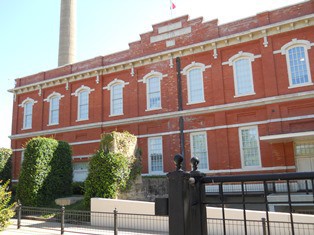 The White Rock Lake Pump Station, a 102-year-old Texas Historic Landmark nestled alongside the lake of the same name, is an integral part of Dallas’ community. In response to increased population and extended droughts in the early 1900s, this facility was built to provide an additional water supply for the City of Dallas. Today, it remains an important structure as the Water Operations Control Center of Dallas Water Utilities. Last restored in the 1980s, this building underwent renovation again in 2012 to stop moisture related problems that had caused deterioration of the facility.
The White Rock Lake Pump Station, a 102-year-old Texas Historic Landmark nestled alongside the lake of the same name, is an integral part of Dallas’ community. In response to increased population and extended droughts in the early 1900s, this facility was built to provide an additional water supply for the City of Dallas. Today, it remains an important structure as the Water Operations Control Center of Dallas Water Utilities. Last restored in the 1980s, this building underwent renovation again in 2012 to stop moisture related problems that had caused deterioration of the facility.
The preservation and renovation of historic properties is an important part of keeping a community alive. An historic building can be a tangible symbol of a community's interest in honoring its heritage, valuing its character and sense of place and getting the most out of prior investments in infrastructure and development. The restoration of the White Rock Lake Pump Station was a careful, methodical process that revived the facility while preserving its architectural history.
Chamberlin Roofing & Waterproofing was the prime contractor for the complete restoration of the White Rock Lake Pump Station. To begin, the EPDM roof system was removed and replaced with a watertight two-ply modified roof, rectifying the previous leaks that had persisted for years. New A/C units were installed, and the terra cotta on the parapet wall cap was restored on the west side of the roof. On the east side, which is the lake side, the terra cotta was too damaged to be salvaged, so it was replaced with matching cast stone. The unstable flagpole mounted to the parapet wall was replaced, relocated and bolted to the rooftop. Finally, lightning protection was installed.
The Masonry Challenge
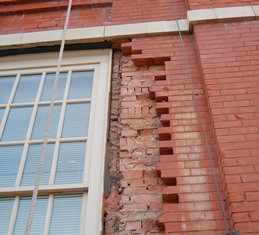
On the exterior envelope, bricks and grout were replaced as needed, and the exterior of the building was cleaned. Chamberlin and Dee Brown, the stone and masonry contractor, teamed up to tackle the masonry restoration, with Chamberlin on the exterior skin and Dee Brown handling the parapet wall. The pump station is constructed of Corsicana Red bricks, a specific color and size of brick popular in 1911. The masonry team planned to have the replacement bricks manufactured, but sadly they were no longer in production. Fortunately, the project architect discovered a building made of the same beautiful red bricks being demolished in Corsicana, Texas, the bricks’ birthplace. Chamberlin retrieved a few to compare, and the project team agreed it was a perfect match for the pump station.
Regarding the mortar on the building, color inconsistencies throughout the existing mortar made finding a color match for the new mortar very difficult. The grout on the lake side of the building had weathered differently than the rest. Patchwork from past years added further inconsistencies. Chamberlin and Dee Brown worked together sampling over 15 different mortar mix variations until a match was found and the process completed.
“Historical accuracy was the drive in selecting the color of mortar and in trying to preserve as much of the terra cotta as possible,” says Dee Brown’s Vice President of Special Projects Division, David Barnes. “I admire the historical preservation of the building through the transformation from what the building was originally built for to what it is used for today.”
Throughout the project, all of the trades’ work held to historical standards and guidelines as they revived the facility’s 1911 charm.
Exterior and Interior Restoration
In addition to the roof replacement and masonry restoration, durable aluminum window replicas replaced the deteriorated 29 original wooden windows. All doors were removed, restored and painted to match the windows.
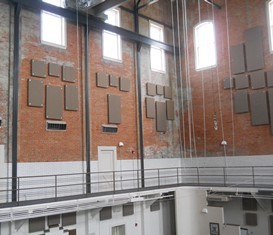
Additionally, an upgraded security system was installed with state-of-the-art cameras and key card readers on every door and at the front gate.
The interior restoration encompassed cleaning the brick and painting the lower level of the large main room. LED, Luminar and emergency lighting were installed. The old, moldy insulation was removed from the ceiling, and new spray insulation was installed. Accessing the ceiling and upper windows in the 60-foot interior was challenging, since appropriate lift equipment would not fit through the building doors. Chamberlin utilized conventional scaffolding reaching within six feet of the ceiling to build a temporary deck allowing access to the underside of the roof. With temporary lighting above the deck illuminating the work area, this design allowed for ideal working conditions with workers being able to reach the ceiling while standing on flat ground.
Since the White Rock Lake Pump Station is a mission critical building providing water to the city, it was crucial that the building continue operating during construction. The server room requires temperature control at all times for its equipment to function properly. Replacing the roof under the A/C unit that cools this room was challenging, as the unit had to continue running.
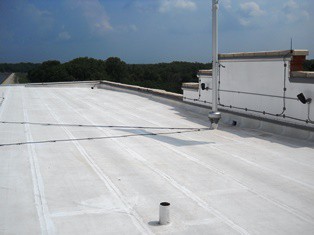
Additionally, due to historical ordinances, the unit could not be raised any higher than its current elevation. Chamberlin and the roofing team came up with a precise plan to move the A/C unit onto jacks at the approved height allowing access to the work and keeping the unit operational. Also, as windows were being replaced, temporary partitions were utilized to control the interior environment. The restoration was completed without interrupting the daily operations of the facility.
Protecting Texas History
For the better of the community and the environment, Chamberlin strives to reduce project waste. All items removed from the facility were either auctioned by the City of Dallas or recycled. Auction items included the original windows and flagpole from the pump station. History lovers and families with deep-seated Dallas roots vied for these items to own a piece of Texas history. The old A/C units, conduit, defective security cameras, brick and stone along with other eligible items were sent to a recycling center.
The White Rock Lake Pump Station, a Renaissance Revival structure, was successfully restored to its former aesthetic glory. Chamberlin’s renovations preserved the waterproof integrity of the building and renewed the life of this historical landmark in the community.
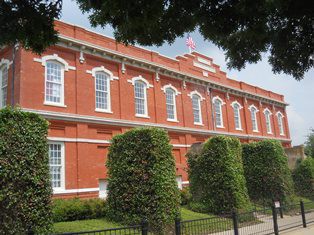
Barnes recounts, “This project was a real team effort between all parties from the owner to the architect to Chamberlin, which helped us in doing our part of the job well. Working with Chamberlin is always a smooth process with good communication and personable, professional people.”
Subscribe Today!
Stay-in-the-know and subscribe to our blog today!